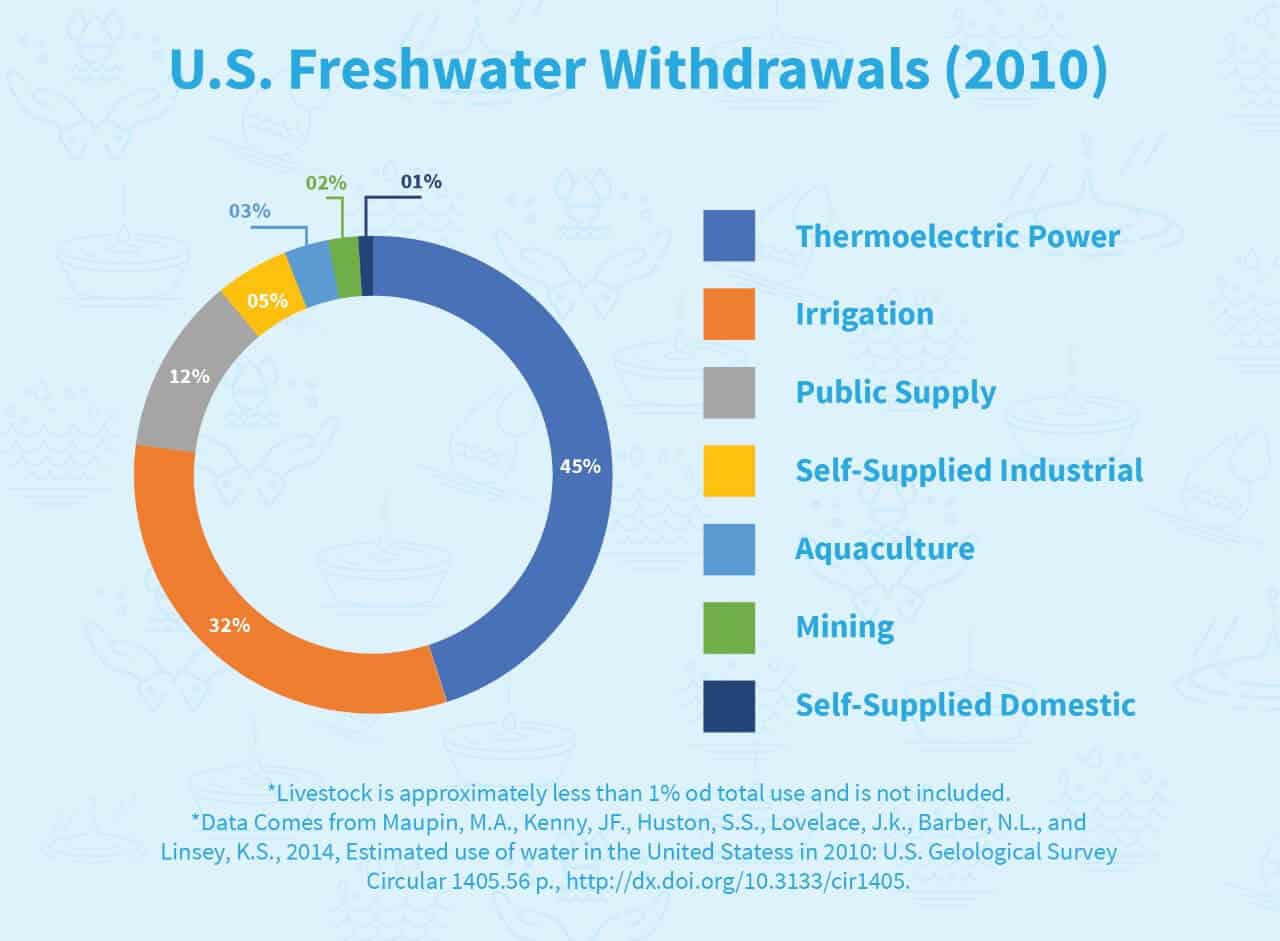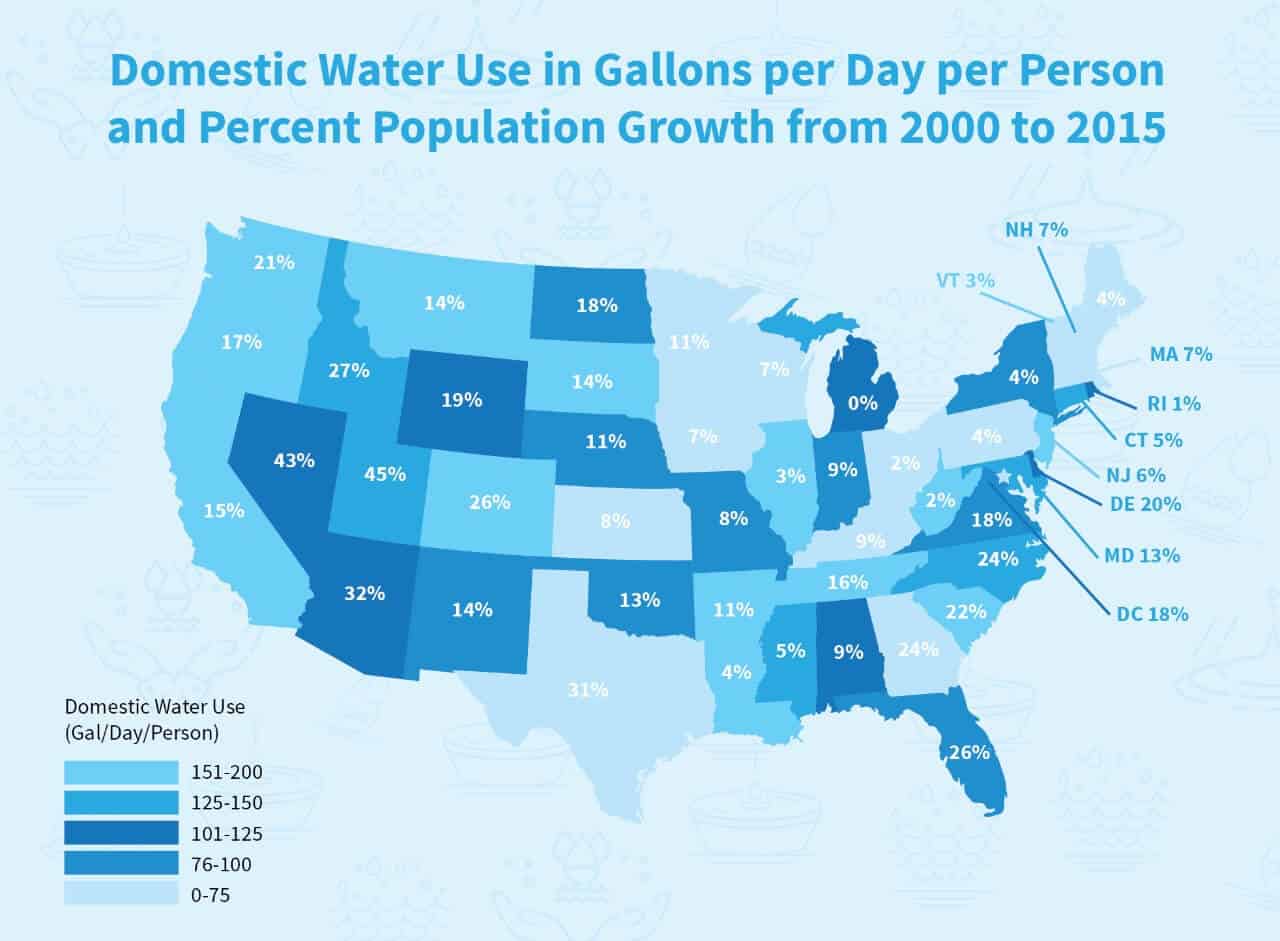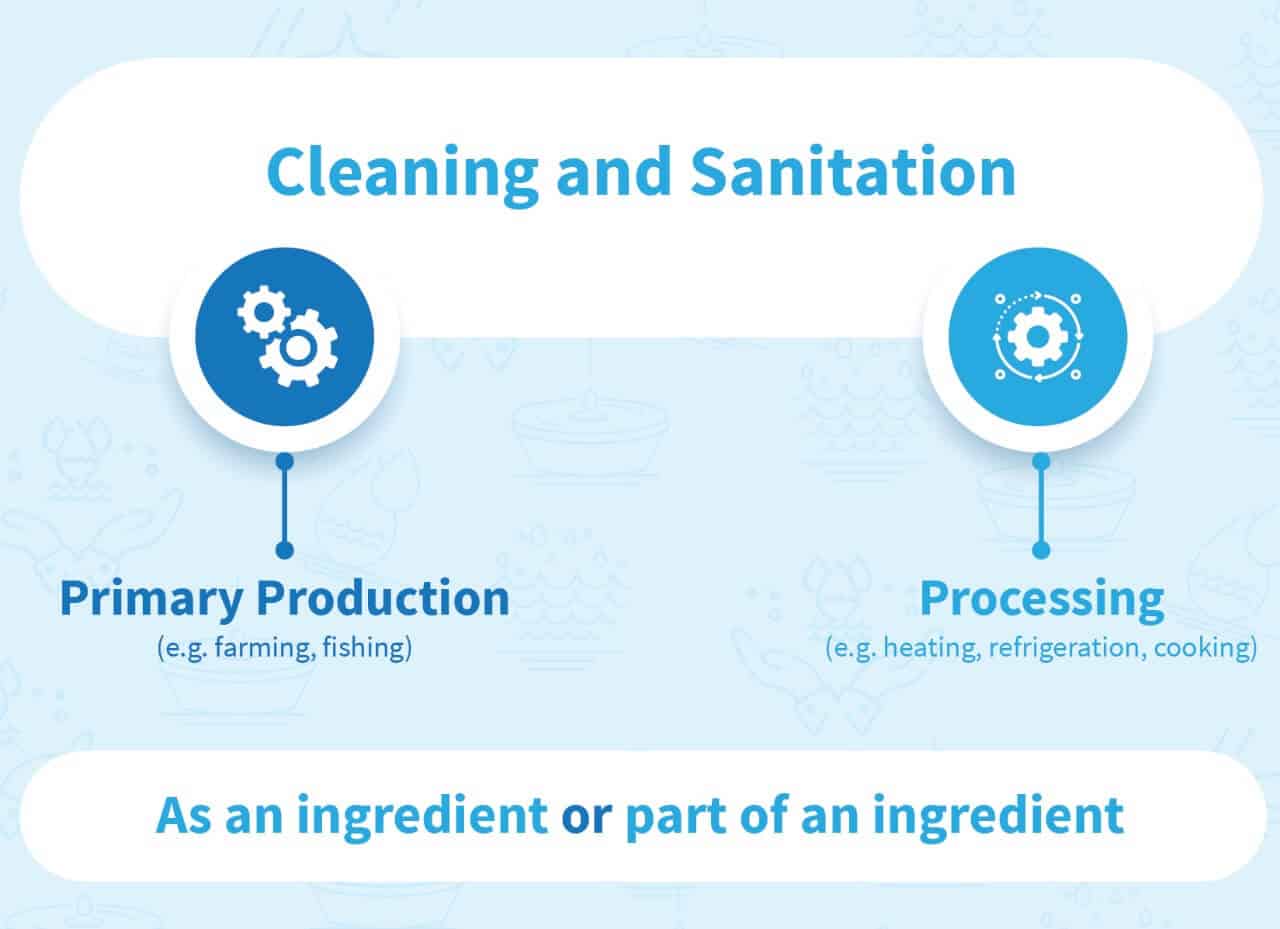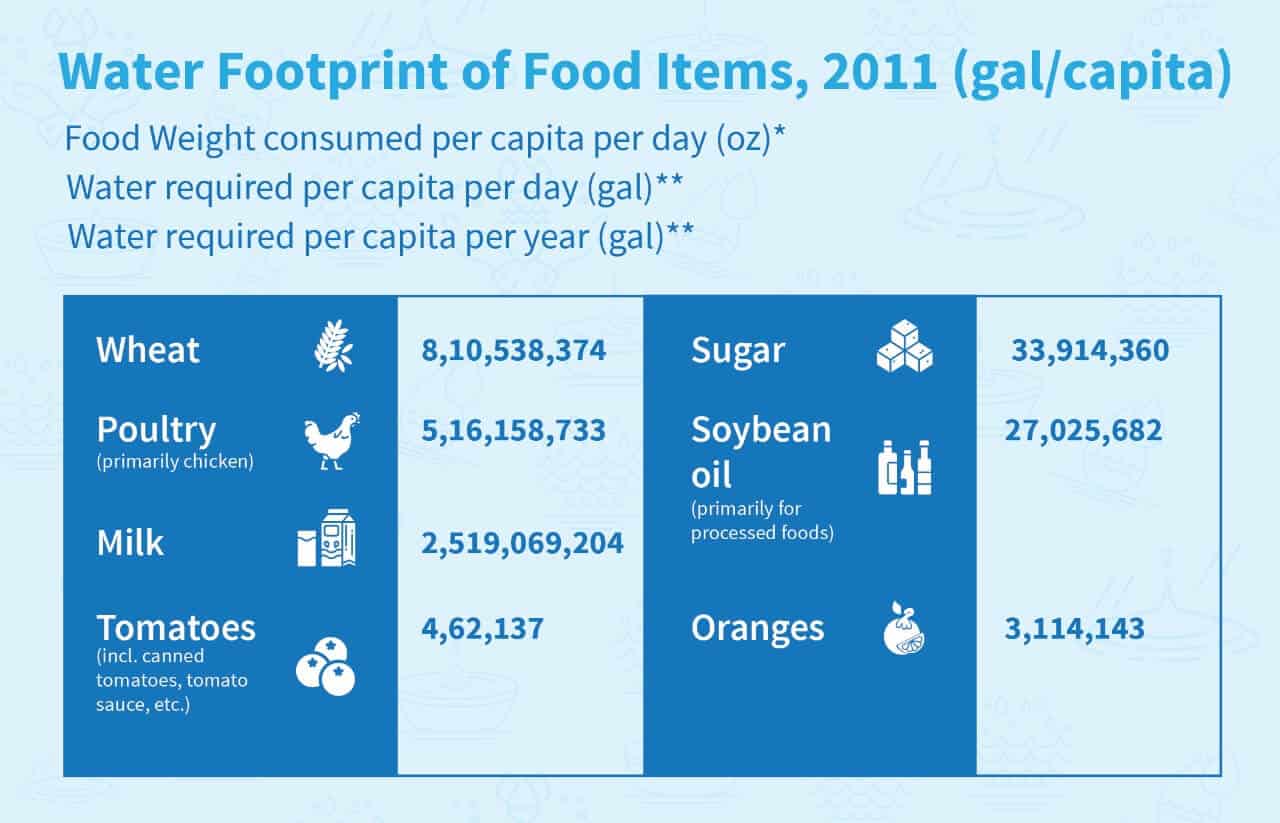What’s the most commonly-consumed drink in the USA? Is it coffee? Coca Cola? Maybe another soda?
No, it’s water of course!
We all need it to live, and need it to thrive, but it’s easy to forget about.
In actual fact, water is an incredibly complex topic.
Water has an affect on every part of our lives, from our health, to our day-to-day happiness and the running of our homes, to how our food is grown and our power is produced.
Increasingly, water is going to become a concern for all of us. That’s true both personally and globally, and includes issues of climate change and water scarcity.
Finally, water is big business! It’s an ever-growing market around the world.
In this article I have broken down every important fact about H2O that I could find, and I hope that you find them all interesting and informative. I’ve even made some informed predictions about what the future of water might look like as we move towards it being a very precious resource.
Water Consumption in the United States (US)
Water infrastructure in the USA has historically been good, but in the past few years it has been faltering. Climate change is having an effect on how much water there is to go around, and trends in water usage and in the consumption of water are shifting the landscape of US water.
In fact, in the last few years an awful lot has changed!
- Between 2014 and 2019, Americans drank more water than any other packaged beverage.
- In the USA, pre-packaged water is a 34-billion dollar industry according to the International Bottled Water Association.
- The average American uses about 50 gallons of water at home every day. That’s 189 liters. The average family uses around 300 gallons (1364 liters) per day according to the United States Environmental Protection Agency.
- On average, 30% of a family’s water use is outdoors but this is much higher is dry parts of the country.
- The average American family’s water usage breakdown like this:

- According to the Wall Street Journal, 20% of Americans avoid drinking water because of its taste. This is fueling a growth in water add-ins for flavor, as well as sales of flavored water.
- In 2015, flavored waters were worth 3.63 billion as an industry in the US, by 2019 that was up to 5.64 billion and that’s predicted to hit 7.29 billion US dollars by 2022 according to Statista.
- In the USA, water usage breaks down like this.

- In many states, though, according to the EPA a combination of projected population growth and high domestic water usage mean the states’ water systems are, or soon will be, stretched.

This issue may lead to one or more of the following:
- Increased water prices
- A loss of public space around lakes and rivers, as more water is used for day-to-day human life
- Costly projects to treat, store and move water within states or even state to state
- Increasingly strict (and increasingly forced) outdoor water use restrictions in the summers
Bottled Water
Bottled water is either a necessity or a luxury, depending on where in the world you live.
In most of the USA, you can drink the water that comes out of the tap but that’s not true all around the world. And anyway, sometimes it’s far more convenient to grab a bottle from a store or the fridge at work. In other countries worldwide water is generally not drinkable, so bottled water is needed for people to survive.
Wherever you are, though, bottled water is big business!
- Despite growing awareness around the environmental damage that single-use plastic bottles cause, bottled water consumption has been rising for some time. In 2013, the average person in the UK used 32.3 liters of bottled water per year in 2013 and 44.9 by 2019, according to Statista.
- In the USA, the average in 2019 was 200 liters, or 44.7 gallons according to Statista. This includes all sizes of bottle, and takes in glass as well as plastic. We also can’t know from this statistic how many of the bottles were recycled, but as ever a reusable bottle is better than buying single-use plastic bottles for personal consumption.
- Interestingly, while sales and consumption of still water have skyrocketed in both the US and worldwide over the past 20 years, fizzy water’s market share stayed comparatively almost static for years. While a growing global middle class will continue to create demand for bottled still water, one Atlantic article quotes an industry expert who believes the gap is only going to widen further over time.
- In the past 5 or so years, however, sparkling water seems to have begun to take some of soda’s market share from it.
- Worldwide bottled water consumption surpassed 111 billion gallons in 2019, according to the International Bottled Water Association.
There are four main types of bottled water recognized by the FDA. They are as follows:
1. Well Water
This is water from a hole drilled or bored into the ground to find an aquifer – an underground layer of water sometimes trapped in rock and sand.
2. Artesian Well Water
Like a well, an artesian well is a hole in the ground that taps into an aquifer. Artesian wells tap specifically into aquifers that are under pressure from the materials surrounding them, like clay, rock and sand. This pressure pushes the water at least part way up and out of well making it easy to retrieve.
3. Mineral Water
Mineral water comes from underground, though the exact extraction method is not important to its classification. It has to contain 250 parts per million total dissolved solids, and the trace elements and minerals that make these up must come from its source. They cannot be added later if you want to water classified as mineral water.
4. Spring Water
Spring water comes naturally to the surface after flowing through underground formations like rivers or tunnels of rock. The water should be collected from the spring where it emerges, or via a borehole into the underground formation through which it flows. Importantly, the collected water must have the same composition as water collected at the spring’s mouth or it cannot be called spring water. This rules out some extraction methods, and means that collecting spring water is comparatively high effort.
Climate Changes Effect of Water
Climate change is intrinsically tied to water. Rain, sea levels, ice, all of these are water based and all of these are hugely swayed by climate change.
Here is just a little bit of what climate change’s effects on water might lead to in the next few decades.
- 70% of the Earth is covered by water, and 97% of the Earth’s water is part of its oceans. About 10% of Earth’s land mass is presently covered by sheets of ice. The ice sheets of the world are losing mass, according to the Intergovernmental Panel on Climate Change, from both surface melting and the thinning and retreat of glaciers. This in turn causes a rise in sea levels.
- According to the UN Water, by 2050 1.6 billion people will live in areas at risk of flooding. This is up from a current 1.2 billion.
- Currently, 27% of the global population, or 1.9 billion people, live in potentially water scarce areas. By 2050 that will rise to between 2.7 to 3.2 billion.
Water Scarcity
Water scarcity is an issue we think of as happening ‘over there’ but actually it’s becoming more and more relevant a worry in countries like the US and UK. Climate change and population growth are driving changes in water needs and the availability of water, and not always in predictable ways.
- Within 50 years, the US’s fresh water supply could be reduced by up to a third according to a government-backed report funded by the US Forest Service. This is because almost half of the USA’s water basins are being threatened by climate change. The situation is exacerbated by rising demand for water.
- In fact, a 2014 Government Accountability Office report found that 40 states expected to experience water shortages in the following ten years that were not related to drought.

- In the USA, National Geographic suggests that one solution to water scarcity issues may be desalination plants. These plants can produce up to 50 million gallons of water per day. Unfortunately, although costs are falling these plants are still expensive to build and run meaning the water ultimately costs more, and it is a challenge to build desalination plants in less economically developed countries where water scarcity is a big problem.
- The water basin issues are repeated worldwide, with the UN Water claiming that over one fifth of the world’s basins are experiencing either flooding or drying up.
- According to the World Health Organization, water scarcity currently affects 4 in every 10 people.
- A UNESCO report states that by 2025, 2/3 of the world population could be under water stress. 1.8 billion people will also live in an area of the world with absolute water scarcity.
Water and Energy
Hydroelectric energy is a massive part of renewable energy plans across the world. But how does it work? And what impact will it have worldwide?
- The US department of Energy’s water power technologies office is in charge of energy produced by water. These are referred to as hydropower or hydroelectricity, and they use the kinetic energy of moving water to produce electricity. Because water exists in a fixed cycle on Earth it is not a finite resource like fossil fuels are, and therefore the energy it produces is more environmentally friendly.
- According to National Geographic, 71% of the renewable energy produced on Earth is hydroelectric.
- China is the largest generator of hydroelectric power in the world, with the USA, Brazil, Canada and Russia also big players.
- The dams and other infrastructure needed to produce hydropower can change or damage natural environments. A study on one Egyptian hydroelectric power plant found, however, that given the positive impact of the renewable energy the environmental impact of the plant was overall positive.
The Science of Water
What is water? Yeah, it’s the wet stuff that comes out the tap. But deeper than that, do you know the science of water? You will when you’ve read this!
- Water is the only natural substance that occurs in all three physical states, that is: liquid, solid, and gas, at temperatures found regularly on this planet.
- Water is unusual because ice, aka solid water, is less dense than liquid water. This means that ice floats, giving us icebergs, and also that it expands as it freezes, giving us a big mess in the freezer if we put a bottle in there!
- Water dissolves more substances than any other liquid. This means that wherever water goes, both in the natural environment and in our bodies, it takes along valuable chemicals, minerals, and nutrients. This moves minerals around the environment and helps us to absorb what we need and get rid of the rest. USGS has more information on this.
- Water has a pH of 7, which is neither acidic (less than 7) nor basic (greater than 7).
- Water boils at a lower temperature at high altitude. This means it actually takes longer to cook food in boiling water at altitude because water begins boiling (and evaporating) before it hits 100c/212f.
Water and Food Production
Food production is one of the largest uses of water worldwide. Increasingly, people are thinking about the water use that went into the food they consume. Plus, we are in need of producing more and more food and that’s only becoming a larger issue. Water is intrinsically tied to food production, and here are a few reasons why.
- Water is used in food production in four main contexts. They are:

- In Europe, the water used in food production should for most purposes be potable (drinking) water, according to European Food Information Council.
- Increasingly, water is also recycled during food production and processing. As the European Food Information Council states, this reused water has to be of the same standard as potable (drinking) water.
- When talking about water in agricultural settings, it is often referred to as “green water” or “blue water”. As a report from the IUSS elucidates, green water is water stored in soil from rainfall whereas blue water is from basins etc. Gray water is contaminated water, usually through agricultural processing.
- The water footprint of a food is the amount of water it takes to grow or produce and process that food. Increasingly, water footprint is becoming a concern for people who are environmentally conscious. Here are the footprints of a few foods as an example:

- Animal products and meat use a lot of green water, whereas grains, cereals and vegetables use a lot of blue through irrigation. According to a meta-analysis published in Advances in Nutrition diets deemed “healthy” (adjusted for national nutritional guidelines) use around 5% less green water to produce but equal blue water to average diets. Water use also varies internationally in terms of food production, with Asian countries’ diets have high blue water patterns, and European and Oceanian diets have higher green water patterns. That implies that Europe and Oceanian are eating far more animal products than Asia.
- According to the World Bank, agriculture will have to expand by about 70% by 2050 to feed a growing population. This means increasing amounts of water will be required year-on-year.
- One solution (or partial solution) to growing water needs in agriculture is drought-resistant plants. As a GreenPeace report explains, these need to be bred and planted in combination with agronomy and biologically-focused farming practices.
Water in Space
The way water is used on space missions will probably inform future water recycling technologies on Earth. In addition, finding water outside our atmosphere shows us a lot about what might happen in future here on terra firma, or what the possibilities of water are. Water in space might seem like an outlandish thing to be interested in, but it is actually very relevant to ongoing water policy.
- According to the European Space Agency, 80% of water on the International Space Station is recycled. This includes water collected from the station’s walls – aka the breath and sweat of everyone working on board!
- In 2011, a ‘lake’ of water around a black hole was discovered. According to Fast Company, it contains as much water as 140-trillion Earths.
- According to Nature, Mars has at least four underground lakes. These were discovered in 2018 and 2020, and have caused a furore in the scientific community, with some people claiming that a lack of heat source on Mars means that the lakes can’t exist in liquid form and others positing that they may be ‘slush or sludge’ rather than liquid water.
- We have known for a while that there is some water on the Moon, but in 2020 NASA discovered that there is water not only in the shadows of the moons mountains and craters but also in sunlit areas.
- NASA is planning to send VIPER, the Volatile Investigating Polar Explorations Rover to the moon in 2023. It will map Moon water courses and investigate the potential for water to help sustain future human Moon exploration missions.
Water and Health
Water is really important for everyone’s health, but you probably know that in the abstract. But why is water so necessary to health? Well, for a start your body is about 60% water. Some important parts are even more water-based. Your brain, for example, is 73% water and so is your heart.
The whole “you need to drink enough water” thing is starting to make sense now right? But beyond that, drinking enough water has a palpable affect on your day to day health and wellbeing.
I’ll go into the key points below, but if you want to know more you can have a look at my comprehensive piece on the 17 most wonderful benefits of water.
- Dehydration can lead to both low blood pressure and high blood pressure, as well as a whole host of circulatory disorders according to a Nutrition Reviews published study.
- Water flushes toxins from your body, including excess minerals and vitamins. Drinking enough water helps to protect your kidneys, which can otherwise be damaged by a buildup of waste products.
- Water may help you lose weight. Of course, replacing sugary drinks with water is a part of this, but some studies have also linked drinking additional water before meals with eating less during meals.
- Water maintains energy levels and helps boost performance during exercise or physical tasks. Studies have found these effects in both adults and children. (1, 2)
- Through sweating, water regulates our body temperature. If you stop sweating, in fact, you might be in trouble, as per Healthline.
- Water is good for your skin! It might even help encourage collagen production according to Healthline.
- Water may help prevent headaches. In fact, one study by BMC Public Health found that 40% of people experience headaches as a symptom of dehydration.
The Future of Water
The future of water is all about making the potable water we have go further, and creating more potable water as cheaply as possible. Of course, another key aspect of ensuring that everyone on Earth has access to clean water is reducing our personal usage where we can.
- Some innovations from startups in the area include water ATM booths from a company called Drinkwell, and automated leakage meters called WaterOn which has saved 40,000 Indian households up to 35% on their water bills.
- According to the EPA, leaks can also add a large amount of water usage and big bucks to American household outgoings too. Finding and fixing leaks can be good for both you and the environment.
- As a potential solution to US water shortages both present and future, Deepika Kurup has come up with a technology that he claims is green, safe, cost-effective and easily deployable. According to The Guardian she won a young scientists’ prize for coming up with a solar-powered water purification process.
Tips to Save the Water
Of course, conserving water and using it as well as we possibly can is a large-scale global problem. But in some ways it is also personal – as mentioned earlier, the average American family uses 300 gallons of water per day at home, and more at work and in pre packaged drinking water. So making small personal changes could make a difference if we all did so!
- Over half of at-home water usage takes place in the bathroom. In there if you want to save water you have a few things to take care of, according to the EPA. The first is easy: turn off the tap while brushing your teeth or shaving. Secondly, remember that showers use less water than baths so save a soak for a special occasion, or if you have kids who need to be bathed wash them all at once! You can also use WaterSense labelled bathroom fittings which are manufactured to the EPA’s water-saving standards. If you’re not in the USA, your own country probably has a similar program to mark water saving products.
- In the kitchen, don’t continually run water as you wash dishes. Plug the sink or use a basin. A dishwasher is also pretty eco friendly, but remember to make sure it’s full when you run it! You should also keep a pitcher of water in the fridge rather than running the faucet until it’s cold, or even better get yourself an energy-efficient water cooler.
- Outdoors, you should be trying not to use your hose or sprinklers more than necessary. That means sweeping driveways and sidewalks rather than using a hose, using a bucket to wash your car, and covering outdoor pools to prevent evaporation.
- When you drink bottled water, make sure the vessel it comes in is recyclable, or even better use a reusable bottle.
Final Thoughts…
It’s clear from these stats that water, or sometimes the lack of it, is deeply entangled with all of our lives. From grabbing a bottle of water after your run, to treating yourself with a bath, to running the dishwasher, you use water constantly.
Sure, on a personal level drinking water is really important for our health and the normality of our lives (I mean, you would not be happy if you could only shower once a week would you?). But increasingly, water is becoming an issue of global security too. Not everyone has access to it, and that is going to become more and more true.
Of course, if we all thought just a little more, and took a few steps, then we could all help save water. It sounds a bit school science fair, doesn’t it? But it really could make a difference! Check for leaks, take showers, minimize your water usage in the garden. I mean, we can hope that some of the amazing water innovations being worked on right now will save us all from water stress but that’s not a forgone conclusion.
As well as revealing our personal water responsibility, these stats tell us a lot about the future of water. Bottled water is an ever-growing business, and as a sign of an expanding international wealthy middle class it will only continue to expand in the next few years. Add to that increasing health consciousness and many people in the US and Europe kicking soda habits and bottled water (both still and carbonated) are going to be growing markets for the foreseeable future.
It’s hard to encompass all the elements of water and its interaction with our daily lives – both behind the scenes and in the foreground. I’ve done my best, but will keep updating these stats as I discover more important information about water worldwide.
Eric, this is an amazing article. I LOVE it!